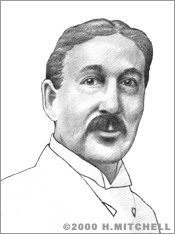King Gillette
At the last turn of the century, King Gillette founded what would become a corporate giant, based on a simple yet essential invention: the safety razor with disposable blades.
Although his ancestors came to Massachusetts from England in 1630, King Camp Gillette was born in Fond du Lac, Wisconsin in 1855. His father was a sometime patent agent and inveterate tinkerer. His mother was an innovator of sorts too; her years of experiments led to a cookbook (1887) that remained in print for 100 years.
The Gillette family moved to Chicago in 1859. Then in 1871, after the Great Fire destroyed their hardware supply business, they moved to New York City. At the age of 17, Gillette became a traveling salesman, who made improvement to his wares as well as selling them. By 1890, he had earned four patents. More importantly, he had learned from the President of his company that disposable items made for big sales.
On the road, Gillette used to shave every morning with a Star Safety Razor, which is a heavy, wedge-shaped blade fitted perpendicularly into its handle. It would have been downright dangerous, in the lavatory of a rumbling train, for Gillette to shave with the type of straight razor used by most men at the time. However, the safety razor did share a major shortcoming with standard razors: the blade had to be sharpened frequently on a leather strop; and even so, the blade eventually became too worn to sharpen.
One morning in 1895, Gillette, now living in Boston, had a revelation. If he could put a sharp edge on a small square of sheet steel, then he could market a safety razor blade that could be thrown away and readily replaced when it grew dull. Gillette visited metallurgists at the Massachusetts Institute of Technology (MIT), who assured him his idea was impossible. It took Gillette six years to find an engineer, William Emery Nickerson (an MIT-trained inventor), who could produce the blade that Gillette wanted.
In 1901, Gillette and Nickerson formed the American Safety Razor Company (soon thereafter renamed for Gillette himself). For the first time, razor blades were sold in multiple packages, with the razor handle being a one-time purchase. Production began in 1903. Gillette won a patent for his product the next year.
Competition was fierce from the start, for two reasons. First, virtually half of the world's population was a potential customer. Second, once the basic idea was made public, modifications multiplied at an incredible rate. For example, Gillette introduced his double-edged blade, of the still familiar type, in 1904; soon, so did many other companies. In a series of patent battles, Gillette Co. often resolved the controversy by buying the competitor. Over the years, he became a kind of international celebrity, since his portrait was featured on the wrappers of the tens of billions of Gillette blades sold all over the world.
In theory, however – and despite his given name – King Gillette had always been an opponent of capitalism. He wrote a number of books promoting a socialist utopia, beginning with "The Human Drift" (1894), in which he declared competition to be the root of all evil. He even presented plans for efficient, pollution-free cities contained in single gigantic, glass-domed, beehive-like communal complexes. Gillette hoped that these would replace the monstrous, sprawling cities that the Industrial Revolution had created.
King Gillette's social engineering efforts never made much headway. In addition, his personal fortune was ruined by the stock market crash of 1929, patent battles, and corporate infighting. Gillette died a frustrated man in 1932.
The Gillette Safety Razor Company survived and thrived. Over the next few decades, it expanded its product line, for example, with the introduction of Foamy shaving cream (1953) and Right Guard antiperspirant (1960). Gillette also acquired a number of personal care product (Braun, Oral-B) and writing implement (Parker, Waterman) companies.
Meanwhile, the mainstay of the corporation has continued to evolve, with the twin-blade razor (Trac-II, 1971), disposable razor (Good News, 1976), pivoting-head razor (Atraë, 1977), and the triple-blade razor (Mach 3, 1999). In 1999, Gillette made $9.9 billion in sales in over 200 countries.


